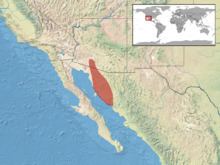Kingdom Animalia Subphylum Vertebrata Suborder Serpentes Scientific name Chionactis palarostris Rank Species | Phylum Chordata Order Squamata Family Colubridae Higher classification Chionactis | |
 | ||
Similar Chionactis, Western shovelnose snake, Chilomeniscus, Gyalopion, Gyalopion canum | ||
Chionactis palarostris, commonly known as the Sonoran shovelnose snake, is a species of small nonvenomous colubrid which is a native of the Sonoran Desert in North America. It is one of only two species in the genus Chionactis.
Contents
Etymology
The specific name, palarostris, is from Latin: pāla (shovel) and rōstrum (beak or snout).
Geographic range
C. palarostris is found in the southwestern United States and northwestern Mexico. In the United States it is found only in Organ Pipe Cactus National Monument of western Pima County, Arizona. The subspecies occurring there is called the Organ Pipe shovelnose snake (C. p. organica). In Mexico it is found only in the state of Sonora.
Description
C. palarostris is cross-banded with black, yellow (or whitish), and red bands. Consequently, it resembles the Sonoran coral snake (Micruroides euryxanthus). The mnemonic "red on yellow kill a fellow, red on black, friend of Jack" doesn't work with this snake. However, unlike the coral snake, which has a black snout, Chionactis palarostris has a yellow snout and is not venomous. Also on a coral snake, the bands go all the way around, but C. palarostris has a solid yellow belly.
The smooth dorsal scales are arranged in 15 rows at midbody; ventrals, 141-181; subcaudals, 34-64, divided.
Maximum total length (including tail) of adults is 43 cm (17 in).
Subspecies
Two subspecies are recognized, including the nominotypical subspecies.
Behavior
C. palarostris is active in the evening and at night, mostly near washes.
Diet
Snakes of the genus Chionactis prey upon insects and other arthropods such as centipedes, scorpions, and spiders. They also eat the pupae of ants, butterflies and moths, and other insects; and they have been known to eat the eggs of small species of lizards.
Reproduction
Sexually mature Chionactis mate in spring, and the female lays a clutch of up to five eggs in summer.
